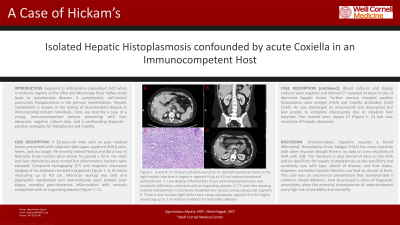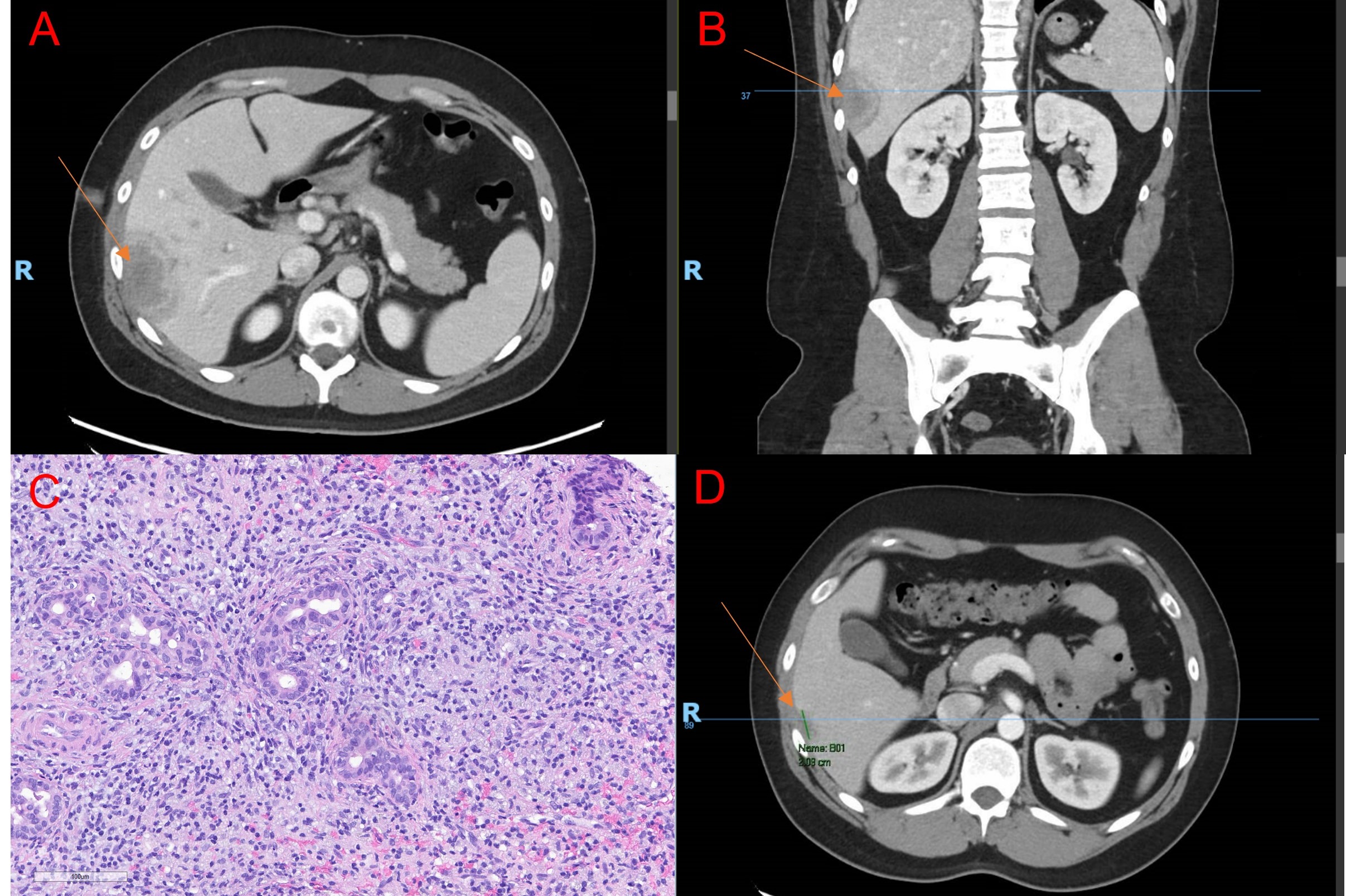Sunday Poster Session
Category: Liver
P1150 - A Case of Hickam’s: Isolated Hepatic Histoplasmosis Confounded by Acute Coxiella in an Immunocompetent Host
Sunday, October 22, 2023
3:30 PM - 7:00 PM PT
Location: Exhibit Hall

Has Audio

Ugochukwu Akpara, MD
Weill Cornell Medical Center
New York, NY
Presenting Author(s)
Ugochukwu Akpara, MD, Neha Nagpal, MD
Weill Cornell Medical Center, New York, NY
Introduction: The majority of liver abscesses are pyogenic or amoebic, while a minority are caused by fungi or parasites. It is well documented that symptomatic histoplasmosis capsulatum typically causes pulmonary histoplasmosis, and hepatic involvement is known in the setting of disseminated disease in immunocompromised individuals. The presentation of Coxiella is variable though most reports describe self-limited viral illness or mild hepatitis. Here, we describe a case of a young, immunocompetent patient presenting with liver abscesses, negative culture data, and a confounding diagnosis - positive serologies for histoplasma and Coxiella.
Case Description/Methods: A 28-year-old male with no past medical history presented with subacute right upper quadrant (RUQ) pain, fevers, and dry cough. He recently visited Florida and did a tour in Nebraska three months prior where he passed a farm. His vitals and liver chemistries were normal but inflammatory markers were elevated. Computed tomography (CT) and magnetic resonance imaging of his abdomen showed a targetoid (Figure 1- A, B) lesion measuring up to 4.0 cm – the differential was broad, including abscess and malignancy. Infectious workup was sent and piperacillin- tazobactam and metronidazole were started. Liver biopsy revealed granulomatous inflammation with necrosis compatible with an organizing abscess (Figure 1- C). Blood cultures and biopsy cultures were negative and interval CT revealed increase in size of dominant hepatic lesion. Further workup revealed positive Histoplasma urine antigen (HUA) and Coxiella antibodies (CaB) (1:64). He was discharged on itraconazole and doxycycline but was unable to complete itraconazole due to elevated liver enzymes. Two months later, repeat CT (Figure 1- D) had near resolution of hepatic abscesses.
Discussion: This case presented a diagnostic uncertainty when searching for a unifying diagnosis. Granulomatous hepatitis requires a broad differential. HUA has cross reactivity with other mycoses though there is no data on cross reactivity of HUA with CaB. The literature is also devoid of data on the HUA and its specificity for hepatic histoplasmosis as the specificity and sensitivity vary with type, extent of disease, and host status. However, untreated Coxiella infection can lead to chronic Q fever. This case was an uncommon presentation that demonstrated a common clinical dilemma - how to proceed in times of diagnostic uncertainty when the potential consequences of undertreatment carry high risk of morbidity and mortality.

Disclosures:
Ugochukwu Akpara, MD, Neha Nagpal, MD. P1150 - A Case of Hickam’s: Isolated Hepatic Histoplasmosis Confounded by Acute Coxiella in an Immunocompetent Host, ACG 2023 Annual Scientific Meeting Abstracts. Vancouver, BC, Canada: American College of Gastroenterology.
Weill Cornell Medical Center, New York, NY
Introduction: The majority of liver abscesses are pyogenic or amoebic, while a minority are caused by fungi or parasites. It is well documented that symptomatic histoplasmosis capsulatum typically causes pulmonary histoplasmosis, and hepatic involvement is known in the setting of disseminated disease in immunocompromised individuals. The presentation of Coxiella is variable though most reports describe self-limited viral illness or mild hepatitis. Here, we describe a case of a young, immunocompetent patient presenting with liver abscesses, negative culture data, and a confounding diagnosis - positive serologies for histoplasma and Coxiella.
Case Description/Methods: A 28-year-old male with no past medical history presented with subacute right upper quadrant (RUQ) pain, fevers, and dry cough. He recently visited Florida and did a tour in Nebraska three months prior where he passed a farm. His vitals and liver chemistries were normal but inflammatory markers were elevated. Computed tomography (CT) and magnetic resonance imaging of his abdomen showed a targetoid (Figure 1- A, B) lesion measuring up to 4.0 cm – the differential was broad, including abscess and malignancy. Infectious workup was sent and piperacillin- tazobactam and metronidazole were started. Liver biopsy revealed granulomatous inflammation with necrosis compatible with an organizing abscess (Figure 1- C). Blood cultures and biopsy cultures were negative and interval CT revealed increase in size of dominant hepatic lesion. Further workup revealed positive Histoplasma urine antigen (HUA) and Coxiella antibodies (CaB) (1:64). He was discharged on itraconazole and doxycycline but was unable to complete itraconazole due to elevated liver enzymes. Two months later, repeat CT (Figure 1- D) had near resolution of hepatic abscesses.
Discussion: This case presented a diagnostic uncertainty when searching for a unifying diagnosis. Granulomatous hepatitis requires a broad differential. HUA has cross reactivity with other mycoses though there is no data on cross reactivity of HUA with CaB. The literature is also devoid of data on the HUA and its specificity for hepatic histoplasmosis as the specificity and sensitivity vary with type, extent of disease, and host status. However, untreated Coxiella infection can lead to chronic Q fever. This case was an uncommon presentation that demonstrated a common clinical dilemma - how to proceed in times of diagnostic uncertainty when the potential consequences of undertreatment carry high risk of morbidity and mortality.

Figure: Figure 1 - A and B: CT coronal and axial view of an ill- defined hypodense lesion in the right hepatic lobe that is largest in segment 6 (up to 4.0 cm) without peripheral enhancement. C: Liver Biopsy; Inflamed liver tissue with lymphoplasmacytic and histiocytic infiltration, consistent with an organizing abscess. D: CT axial view showing marked improvement in previously visualized liver abscess along subcapsular segment 6. There is now residual slight defect seen along subcapsular segment 6 in this region measuring up to 2 cm without evidence for drainable collection.
Disclosures:
Ugochukwu Akpara indicated no relevant financial relationships.
Neha Nagpal indicated no relevant financial relationships.
Ugochukwu Akpara, MD, Neha Nagpal, MD. P1150 - A Case of Hickam’s: Isolated Hepatic Histoplasmosis Confounded by Acute Coxiella in an Immunocompetent Host, ACG 2023 Annual Scientific Meeting Abstracts. Vancouver, BC, Canada: American College of Gastroenterology.
